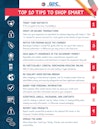Former Vice President of Brand Protection & Strategic Initiatives, Global Innovation Policy Center (GIPC), U.S. Chamber of Commerce
Former Executive Director, Global Brand Council, U.S. Chamber of Commerce
Published
September 03, 2020
Right now, amid the COVID-19 pandemic, everyone is working toward one goal: getting children back to school safely and responsibly.
As public officials tackle dizzying logistics around in-person versus virtual learning, mask ordinances, and social distancing, parents are beginning their back-to-school shopping. It’s no question that this year’s shopping will look different than in years past. Still, the same rule applies: parents should be extra vigilant to avoid counterfeit goods.
Typically, fake versions of children’s favorite branded apparel and toys are the back-to-school shopping season’s biggest culprits. They come with their own dangers: subpar materials, choking hazards, and harmful toxins.
But this year, clothing and toys have shifted to the bottom of shopping lists, replaced by things like cleaning supplies, personal protective equipment, and even pharmaceuticals. Trips to the supermarket or the mall have been replaced by a few clicks on the computer. Malicious counterfeiters are following these trends, and they’re waiting to trick unwitting consumers. You don’t want to wait to see the consequences for yourself.
Just a few weeks ago, in Nogales, Arizona special agents with Homeland Security Investigations (HSI) and U.S. Customs and Border Protection (CBP) officers assigned to the Trade Enforcement Coordination Center confiscated nearly 900 bottles of counterfeit bleach, as well as counterfeit hand sanitizer, surface cleaner and other cleaning supplies. Scientific testing revealed that the primary ingredient in many of the products was only water. Meanwhile, the bottles didn’t have safety seals – presumably, they were packaged without heed to standard safety and hygiene standards.
In a different raid in Los Angeles, agents found hundreds of counterfeit N95 respirator masks – the masks had simple ear loops, while authentic ones have bands that stretch across the back of the head to provide the necessary tight seal around the mouth and nose. The agents also suspected that the masks lacked the signature filtering electrocharged fibers and sent them to a lab for analysis.
Other raids in Baltimore and Philadelphia have intercepted non-federally compliant thermometers and non-FDA-approved cold medicines. Best case scenario, these products don’t work, and you miss a fever or take a placebo. Worst case scenario, they’re toxic, and make you even sicker. The same case holds true for the thousands of counterfeit COVID-19 test kits, treatments and “cures” that have been stopped at our borders.
Fortunately, in all these instances, the dangerous products never reached the consumer. Overall, as part of Operation Promise – the HSI workstream dedicated to fighting COVID-19-related crime – agents have conducted 969 COVID-19 related product seizures and made 59 criminal arrests. They’re working hard to keep you safe. But they need your help.
Consumer protection against counterfeit goods must begin with consumer education about counterfeit goods. Our top 10 tips to shop smart can help you identify and avoid counterfeits this fall, especially as COVID-19 raises the stakes. You can use our tips to teach your children, your friends, and your family, and encourage them to spread the word even further. Because shopping smart is a lesson no one wants to learn the hard way.
For more resources on shopping smart and staying safe this fall season, visit our Shop Smart Toolkit here.

About the authors
Kasie Brill
Kasie Brill is the former Vice President of Brand Protection and Strategic Initiatives at the U.S. Chamber of Commerce’s Global Innovation Policy Center (GIPC) and former Executive Director of the Global Brand Council.




